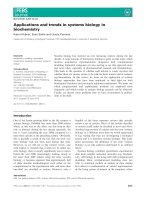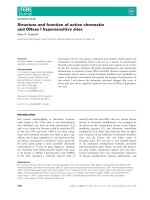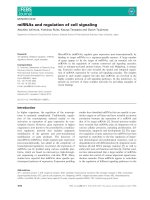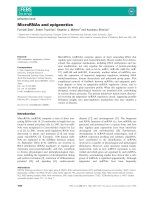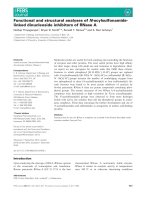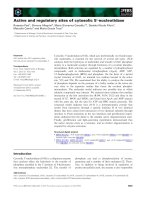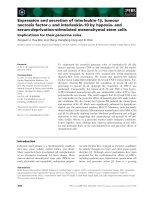Báo cáo khoa học: "SITUATIONS AND PREPOSITIONAL PHRASES" pptx
Bạn đang xem bản rút gọn của tài liệu. Xem và tải ngay bản đầy đủ của tài liệu tại đây (233.79 KB, 4 trang )
SITUATIONS AND PREPOSITIONAL PHRASES
Erik Colban and Jens Erik Fenstad
University
of
Oslo
Institute of Mathematics
Postboks 1053 Blindern
N-0316 Oslo 3, Norway
ABSTRACT
This paper presents a format for representing the
linguistic form of utterances, called situation
schemata, which is rooted in the situation semantics
of Barwise and Perry. A treatment of locative
prepositional phrases is given, thus illustrating the
generation of the situation schemata and their
interpretation in situation semantics.
Introduction
A natural language system aims to provide an
overall framework for relating the linguistic form of
utterances and their semantic interpretation. And the
relation between the two must be algorithmic. In this
paper we pursue an approach which is based on an
algorithm for converting linguistic form to a format
which we call a situation schema.
A situation schema has a well-def'med formal
structure, suggestive of logical form. This is a
structure which is different from the standard model-
theoretic one; we will argue that it is a structure better
adapted for the analysis of the meaning relation in
natural languages. A situation schema is effectively
calculable from the linguistic form and we believe
that it provides a format usefull for further
processing, e.g. in the construction of a natural
language interface with a data system and also in
connection with mechanical translation systems.
The general structure of situation
schemata
We begin by explaining the general structure of
the situation schemata and how they, are rooted in the
situation semantics of Barwise and Perry (Barwise
and Perry 83).
Situation semantics is grounded in a set of
prinutives
S situations
R relations
L locations
D individuals
The
format of a bas/c
(located)fact is
at I: r, al, ,an; 1
at 1: r, al an; 0,
the first expresses that at the location 1 in L the
relation r in R holds of the individuals al an in D;
the second expresses that it does not hold.
A s/mat/an s in S determines a set of facts of the
form
in
s:at l:r, al an; 1
or
in
s:at l:r, al
an; 0.
We can think of a situation s as a kind of
restricted, partial model (data base) which classifies
certain basic facts. The set of primitives <S,L,R,D>
may come with some internal structure, e.g. the set L
of locations is or represents connected regions of
space time and thus could be endowed with a rich
geometric structure. We shall see how this can be
exploited in our analysis of locative prepositional
phrases.
A situaion schema is a complex feature-value
structure computable from the linguistic form of the
utterance and with a choise of features matching the
primitives of situation semantics:
"REL
ARG1 -
AEEm -
LOC
.POL -
Here the features REL ARG1, ,ARGn, arid LOC
correspond to the primitives: relation, individuals,
258
location. POL, abbreviating polarity, takes either the
value 1 or 0. The values in the schemata can either be
atomic or complex feature-value structures. The value
of the LOC feature is always complex.
The interpretation of a situation schema is relative
to an utterance situation u and a described situation s.
The utterence situation decomposes into two parts
d
discourse situation
c
the
speaker's
connections
The discourse situation contains information about
who the speaker is, who the addressee is, the sentence
uttered, and the discourse location. The latter
information is necessary to account for the tense of a
sentence. The speaker's connections is a map
determining the speaker's meaning of lexical items.
The meaning of a sentence ~ 1 is a relation between
the utterance situation u (=d,c) and a described
situation s. We write this relation
d,c [srr.,h]
s,
where SIT. t)lden°tes the situation schema of 01.
Remark. In
other works, e.g. (Fenstad
et.
al.
87),
we
have developed the mathematical study
of
the
structures <S,L,R,D>; in particular, several
axiomatization theoremes have been proved, providing
a complete inference mechanism for a multi-sorted
logic based on a semantics of partial information.
Since the model theory of these sU'uctures seems to
be a natural formalism for a (relational) data base
theory, it would be interesting to build a PROLOG-
style system based on the proof-theory which we
have developed.
Oblique objects
and adjuncts
In the next section the general theory will be
illustrated by the analysis of a couple of sentences that
contain locative prepositional phrases. In this section
we make some preliminary remarks. See (Colban 85)
or (Fenstad eL al. 87) for more details. The PP's we
consider here are all attached to a verb (not a noun
phrase), and will be divided into two classes: oblique
objects and adjuncts (Kaplan and Bresnan 82). An
oblique object fills one of the argument slots of the
verb if one considers the verb to be a relation with a
fixed number of arguments. In e.g. the sentence 'Tom
handed the book to Anne" the verb handed is a
ternary relation with arguments Torn, the book and,
one migth say, Anne. However, we will consider the
third argument to be something that has to be in the
relation to to Anne. An oblique object is thus a
constraint on an (unexpressed) argument of the verb.
This way a verb may have several oblique objects
without the number of arguments necessarely
increasing. In the sentence ''Tom sent a letter from
Norway to France" both from Norway and to
France are constraints on the same argument.
Adjuncts function normally by restricting or
modifying the relation expressed by the verb.
Examples are: "Tom played with Anne " and "Tom
ate in a hurry. " Sometimes the location where the
relation takes place is modified and not the relation
itself. In e.g. 'Tom ran to the car" the location will be
restricted to be in the relation to to the car. This
relation will hold if the location is a curve Izacing the
trajectory in space-time that ends at the (location of)
the car.
The situation schemata in the examples below have
been produced by a parser for LFG-grammars.
Usually, f-structures are produced by such a parser,
but we have written a grammar that causes situation
schemata to be produced instead.
Examples
Examvle
1:
¢1: Peter ran to the car.
The situation schema S1T.~I is:
"gEL ma
ARG1 Peter
I,OC
IND
COND
IND2
"REL < ]
AI~I IND 2
.AP4~210
"REL
to
AP4~I IND2
lIND
IND1
/ /A I mD
| LPOL
LSPEC THE
.POL 1
.POL 1
259
The PP is here taken as an adjunct
since
ran is a
unary relation. The values of the ARGi in the
schemata can either be direct references to individuals
(e.g. Peter) or /ndeto-m/nates with or without
associated constraints (e.g. 10, IND1, IND2). The
indeterminates have to be anchored to individuals or
locations in such a way that the conslraints hold in the
described situation. The ARG2 in the second
constraint of SIT.O I'LOC'COND is:
COND [REL
car
ARG1 IND
LFOL
LSPEC THE
This schema tells us that IND1 has to be anchored
to an individual a that must
be a car. The
SPEC
feature can
either be used to pick out the
unique car in
the described situation or to make a generalized
quantifier out of ARG2. The situation schemata are
hence open to several interpretations.
The LOC feature in this schema has the structure:
l
IND IND2 ]
COND
{ }
The location is tied to a location indeterminate
IND2. The COND feature is a set (notice the set
brackets) of constraints on IND2. The first one
expresses that ND2 must be anchored to a location I
that temporally precedes the location that 10 gets
anchored to. By convention 10 is always anchored to
the discourse location I d. This constraint accounts for
the past tense of
ran. In the
second constraint the
semantics of
to
tells us that 1 must be a curve in
space-time that ends at the location of a. The head-
relation run in SIT.~
1
asserts that the individual
named Peter is in the state of running along the
trajectory 1. An interesting project would be to furnish
the domain L of locations with a set of "primitive"
relations
which
could be used to spell out the meaning
of the different prepositions. For the moment the only
primitive relation on L that has been accounted for in
the axiomatizatlon of the structure <S,L,R,D> is "<",
the relation "temporally precedes."
A more precise interpretation of S1T.O 1 is:
The relation d,c [S1T.O1 ] s holds if and only if
there exists an anchor g on S1T.~ I'I'£X~, i.e.
~0): ld
g(IND2) < g(1 O)
andanextensienf ofg that anchorsIND1
such
thatf(IND1)
is the unique individual
such
that in s: c(car),f(IND1); 1
such that
in s: c(to), gtlND2),f(IND1); I
ins: at g(IND2 ): c(run), c(Peter); I
Note that relations between locations can easily be
extended to include individuals among their
arguments. This is done by introducing a function
/oc~f from D to L mapping individuals on their
locations. A relation r between locations is extended
to a relation r' where some of the arguments are
individuals by letting:
r', al, ; pol ~f r loc.ofla i), ; pol.
Examole
2:
(;2:
The
book was lying
on th~ ~bl~.
The situation schema SIT.02 is:
"REL
lie
IND IND1
REL book ]
AROl COND AI~I IND1
l
LPOL 1
LSI~C THE
"IND
AR~ COND'
IND5
REL
on
ARG1 IND5
lIND IND4
,,I
.POL I
r o o2
]]]
/COND 1/A 1 IND2
L LLARG2
IO
,POL 1
260
The PP gets here two readings; one as an adjunct
and one as an oblique object, but we have omitted the
adjunct reading since it isn't natural. The relation lie
takes two arguments: ARG1 end ARG3. The
indeterminate IND2 must be anchored to a location
that temporally precedes the discourse location. IND1
must be anchored to an individual al which is the
unique book in the discourse situation, and ~ must
be anchored to an indivildual a2 which is the unique
table in the discourse situation. SIT.~2.ARG3.COND
forces IND5 to be anchored to an individual a3 such
that the relation on holds between a3 and a2. The
relation lie will hold between al and a3 if al is lying
and the locations of al and a3 are the same.
A precise interpretation is:
The relation d,c [SIT.02] s holds if and only if
there exists an anchor g on SIT.~b2.L(X~, i.e.
g:lo) td
g(IND2) < g(l O)
and an extension fof g that anchors IND1, IND4
and IND5
such thatf(IND1) is the unique individual
such that/n s: c(book),fllND1); 1
andfllND4) is the unique individual
such that/n s: c(table),fllND4); 1
such that
in s: c(on),/(IND5)j?IND4);
1
in s: at g(IND2): c(lie),f(IND1),f(INDS); I
REFERENCES
[1] J. Barwise and J. Perry (1983), Situations and
Attitudes, MIT Press.
[2] E. Colban (1985), LFG & preposisjonsfraser i f-
strukturer og situasjonsskjemaer (Norwegian)
Cand.scient thesis, University of Oslo.
[3] J.E. Fensta& P.K. Halvorsen, T. Langholm, L
van Benthem (1987) Situations, Languages and Logic,
Reidel. (Preliminary version: Report 29,CSLI,
Stanford University).
[4] R. Kaplan and J. Bresnan (1982), Lexical-
Functional Grammar: A Formal System for
Grammatical Representation, in J. Bresnan (1982),
The Mental Representation of Grammatical
Realations, M1T Press.
[5] S.M. Shieber(1986), An Introduction to
Unification-Based Approaches to Grammar, CSLI
Lecture Notes No.4, Stanford.
Final remarks
This analysis has been implemented on a XEROX
1109/1186. Other fragments have been implemented
using the D-PATR format. In a study of direct
questions (E. Vestre) it turned out to be advantageous
to use a DCG-grammar and a PROLOG-
implementation. The spirit of the algorithms are
however the same, unification and constraint
propagation (see (Shieher 86) for a general
discussion). We are now studying the problem of text
generation based on situation schemata augmented by
certain pattern information.
261
